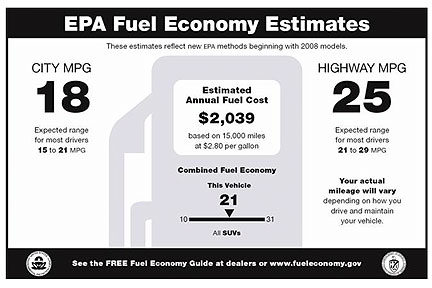The window sticker says your new car is rated 18 mpg city and 25 mpg highway, but you never are able to get more than 17 mpg. This is about to change. No, vehicles won't get better fuel economy. The EPA estimates will just be closer to what you can expect under real world driving conditions. The new EPA standards take effect for model year 2008 vehicles, some of which go on sale as soon as February 2007.

|
| New window stickers will make it easier for consumers to compare fuel economy when shopping. It features more prominent fuel cost information, user-friendly graphic for comparing the fuel economy of different vehicles, clearer text, and a Web site address for more information. |
Currently, EPA uses two laboratory tests to estimate the city and highway fuel economy. They are performed under mild climate conditions (75 degrees F) and include acceleration rates and driving speeds that are generally lower than those used by drivers in the real world. The highway test has a top speed of 60 mph, and an average speed of only 48 mph. Neither test is run while using air conditioning.
These test methods were revised in 1984 by across-the-board downward adjustments, rather than by vehicle-specific testing. The reductions -- 10% for city and 22% for highway -- more accurately reflect driving styles and conditions. However, some vehicles are more sensitive to these factors than others, so reductions should vary from vehicle to vehicle.
Since the mid-1990s, EPA's emissions certification program has used three additional tests that better reflect real-world driving conditions. These include high-speed, fast-acceleration driving; use of air conditioning and colder temperature operation (20 degrees F.) Until now, these tests were not required to measure fuel economy. The new tests will also reflect other conditions influencing fuel economy, like road grade, wind, tire pressure, load and different fuel properties.
The EPA is quick to point out the changes are a result of changes in how it estimates city and highway miles per gallon (MPGs,) not the result of changes made by the automobile manufacturers. Indeed, under these new test methods fuel economy ratings will drop for most vehicles.
Compared to today's estimates, the city MPG estimates for most vehicles will drop by about 12% on average, and by as much as 30% for some vehicles. The highway MPG estimates will drop on average by about 8%, and by as much as 25%.
Hybrids will fare worse. new city estimates will be about 20 to 30% lower than today's labels, and new highway estimates will be 10 to 20% lower. The addition of a battery as a second source of on-board power, sophisticated control systems, and sometimes a smaller engine makes a hybrid's fuel economy more sensitive to certain factors, such as colder weather and air conditioning
For the first time, EPA will be requiring fuel economy labeling of medium-duty vehicles between 8,500 and 10,000 pounds. This includes large SUVs and vans. Manufacturers will be required to post fuel economy labels on these vehicles beginning with the 2011 model year.
These new rules have no impact on the CAFE (Corporate Average Fuel Economy) standards that are governed by different regulations. CAFE is the required average fuel economy for a vehicle manufacturer's entire fleet of passenger cars and light trucks manufactured for sale in the U.S. for each model year.
Since driving behaviors and conditions vary, no test perfectly predicts the fuel economy that every driver will get. Your fuel economy may be higher or lower. However, the EPA's new test methods will do a better job of bringing the estimates on the window sticker closer to people's real-world fuel economy experience.




